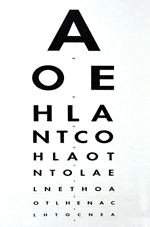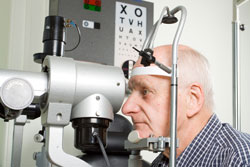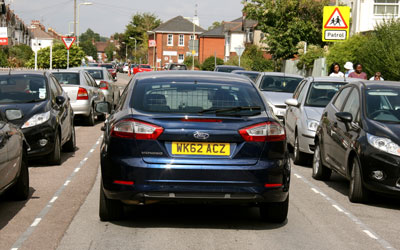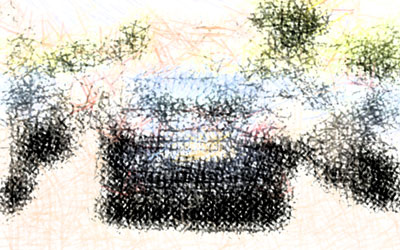Eyesight

In good daylight, you must be able to read a vehicle number plate from a distance of 20 metres (or from a distance of 20.5 metres for old style number plates).
If you want to do your own number plate test, when walking down a street or in a car park, 20 metres is about 5 car lengths.
You must also have an adequate field of vision and a visual acuity of at least decimal 0.5 (6/12) on the Snellen scale (with glasses or contact lenses, if necessary), using both eyes together or, one eye only if the driver only has sight in one eye.
If you need glasses or contact lenses to drive, you must wear them at all times when driving (see Rule 92 of the Highway Code). It is an offence not to do so, and may invalidate your motor insurance. It is a good idea to keep a spare set of glasses in the glove compartment.
Eyesight Tests
The best way to make sure that you meet the minimum eyesight standard for driving is to have an eyesight test at an opticians every two years, or more often if the optician advises.

You are entitled to a free eye test if you are 60 years or over, or have been diagnosed with diabetes or glaucoma or have been advised by an ophthalmologist that you are at risk of glaucoma. If you are 40 years or over, and have a mother, father, brother, sister, son or daughter who has been diagnosed with glaucoma, you are also entitled to a free NHS sight test. You can also receive free eye tests if you receive certain social security benefits.
Any condition that affects both eyes (or the remaining eye if you only have one eye), except long and short sightedness and colour blindness, should be reported to the DVLA (or the DVA in Northern Ireland). This does not necessarily mean you would lose your licence – an assessment of your eyesight will be made.
Eyesight can deteriorate gradually over time, and it can be difficult to realise it has fallen below the minimum standard. For instance, as we grow older our eyes become less able to react quickly to changes in light and we start to have difficulty with colours and contrasts in poor light. Between the ages of 15 and 65 years the time it takes to recover from glare increases from 2 to 9 seconds. This could be one reason why some people find driving at night more difficult.
This video from the Older Drivers' Forum gives helpful advice on driving at night.
Police Roadside Eyesight Tests
The Police can, and do, require drivers who they have stopped to take an on-the-spot roadside eyesight test to prove that they can read a number plate from 20 metres if they are concerned about their eyesight. If a driver is not able to pass this test, they are advised that getting back behind the wheel would be an offence because they have failed to meet the legal eyesight standard.
The officers can immediately email a request to the DVLA to have the driver’s licence revoked and the DVLA can issue a formal revocation notice which could be delivered to the offending driver on the same day. This is known as “Cassie’s Law” in memory of a young woman who was killed by a driver who had failed a roadside eye test but continued to drive while the Police were trying to get his licence revoked.
Common eyesight conditions that can affect drivers

Good vision

Cataracts
The eye lens becomes cloudy, leads to blurred vision and sensitivity to glare.

Diabetic Retinopathy
Caused by diabetes, results in patches of vision loss and thereby lacks sharpness across the visual field. It becomes difficult to read and drive.

Glaucoma
Loss of peripheral vision. Retinitis Pigmentosa also causes tunnel vision, resulting in side vision loss.

Macular Degeneration
A common eye condition in which central vision deteriorates.

Blindness
The loss of all useful vision, although shades of light and dark may still be visible.
Further Information
Macular Society
PO Box 1870,
Andover SP10 9AD
Helpline 0300 30 30 111
info@macularsociety.org
Online Contact Form








